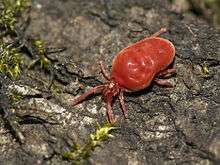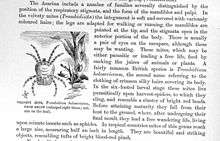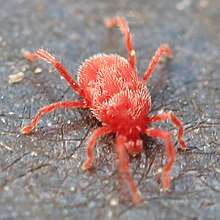Trombidium holosericeum
Trombidium holosericeum is a species of mite in the genus Trombidium. It occurs in Europe, Asia, and North Africa and is commonly confused with other red mite species.[1]
| Trombidium holosericeum | |
|---|---|
 | |
| Adult T. holosericeum | |
| Scientific classification | |
| Kingdom: | Animalia |
| Phylum: | Arthropoda |
| Subphylum: | Chelicerata |
| Class: | Arachnida |
| Subclass: | Acari |
| Order: | Trombidiformes |
| Family: | Trombidiidae |
| Genus: | Trombidium |
| Species: | T. holosericeum |
| Binomial name | |
| Trombidium holosericeum | |
| Synonyms | |
|
Acarus holosericeus | |

Description

This species is one of the largest mites in northern temperate zones, with a body length of just over 1/8th of an inch, about 4 mm. The soft, brightly red body is covered with fine hairs, giving it a velvety appearance. The small eyes are located on stalks. They have scissor-like chelicerae and their pedipalps are used as touch organs.
Its bright red color results from carotenoids, warning predators about the toxicity of the mite (aposematism). Almost nothing is known about the toxic substances used, but they are probably contained within the integument.
The specific epithet is derived from Ancient Greek holo "whole" and seric- "silken".
Biology
While adults live freely and are often found wandering about, searching for small animals and insect eggs for food, the larvae try to find a host to attach themselves to, often an insect like a grasshopper or diptere, but also arachnids like harvestmen or spiders. At this stage they are seen as red globules on their hosts, sucking body liquid without severely harming the host. These larvae then develop into free-living nymphs that resemble adults.
References
- Mąkol, J.; Wohltmann, Andreas (2000). "A redescription of Trombidium holosericeum (Linnaeus, 1758) (Acari: Actinotrichida: Trombidioidea) with characteristics of all active instars and notes on taxonomy and biology". Annales Zoologici. 50 (1): 67–91.
Further reading
- Synopsis of the described Arachnida of the World: Trombidiidae
- Bellmann, Heiko: Spinnentiere Europas. Kosmos, Stuttgart 2001, ISBN 3-440-09071-X (German)
| Wikimedia Commons has media related to Trombidium holosericeum. |